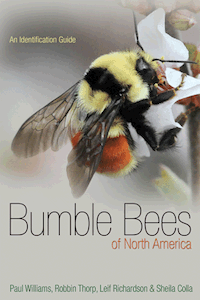Whenever one hears about bees these days, it is almost invariably to the European honey bee, Apis mellifera, that the reference is being made. Indeed, the health of this species is of justifiably great concern, but it is by no means the only species of bee on the planet. Among the approximately 20,000 species of bees known to science, there are mason bees, digger bees, sweat bees, polyester bees, carpenter bees, mining bees, and of course, bumble bees.
Of all these, this last is perhaps the one most popularly known and readily identifiable – or at least many might think. In truth, the “friendly,” “fuzzy” bumble bee so commonly known to backyard gardeners is actually a member of a genus comprising some two hundred fifty distinct species, forty-six of which are found in North America north of Mexico (well, forty-five actually as one may now be extinct). And it is these very forty-six that are the subject of Bumble Bees of North America: An Identification Guide.
Very much to the credit of its authors, Bumble Bees of North America is far more expansive in its scope than just a guidebook to the needed information for identifying of each of its included species. Before the individual species accounts even begin, there is a fifty page introduction that covers how to observe and attract them, their ecology and general life history, threats to their well-being, bumble bee mimicry (both Batesian and Müllerian), how they are scientifically classified, and how the book itself should be used as a tool in identifying them. Indeed, so clearly written and well organized are these introductory sections that they serve very well as both as a first lesson to the absolute new-comer to the natural history of bumble bees and as an overview of the genus to the experienced naturalist and even the professional entomologist, ecologist, or general biologist.
Then there are the species accounts. As the authors clearly explain in their introduction, identifying bumble bees to the species is not something that can always be accomplished in the field. Given that the castes (queens and workers) – as well as the males – of each species can potentially appear in a variety of different color patterns, there is only so much that can be done in the field, even with a hand lens, to arrive at a reliable species-level identification.
However this is not to in any way discourage the casual amateur naturalist. For those not interested in collecting individual specimens, the species accounts – each complete with range maps and yearly activity graphs as well as textual information describing such pertinent items as range, habitat, and behavior – provide a wealth of information that can lead the reader to a better understanding of which species might be found in a particular area. And thanks to a very cleverly designed scheme of diagrammatic color pattern icons, it is often possible to reach at least a general idea of an individual bee’s identity without collecting it and examining it under a microscope.
Of course, for those needing – or simply interested in – going deeper and securing species identifications, each species account includes detailed information for examination of the specimen in hand as well as under a microscope. A section of comprehensive identification keys for female as well as male bumble bees – with photos – is also included following the species accounts.
Because of their importance as a pollinator, their ubiquity (in various species, of course) across the continent, and simply because the lives and behaviors bumble bees are so fascinating, Bumble Bees of North America should be considered as a must-read by all amateur naturalists. Professionals – be they entomologists, ecologists, general biologists, and most especially teachers of life science subjects at all levels – would also do well to add it to their reading lists for both its superb introduction to the genus as well as its value as a reference guide.
 Title: Bumble Bees of North America: An Identification Guide
Title: Bumble Bees of North America: An Identification Guide
Authors: Paul H. Williams, Robbin W. Thorp, Leif L. Richardson, and Sheila R. Colla
Publisher: Princeton University Press
Format: Paperback
ISBN: 9780691152226
Date: 2014
Pages: 208 pp. With 150 color illustrations
(Also available as an eBook – ISBN: 9781400851188)
In accordance with Federal Trade Commission 16 CFR Part 255, it is disclosed that the copy of the book read in order to produce this review was provided gratis to the reviewer by the publisher.
If you enjoyed reading this, please consider signing up for The Well-read Naturalist's newsletter. You'll receive a helpful list of recently published reviews, short essays, and notes about books in your e-mail inbox once each fortnight.
